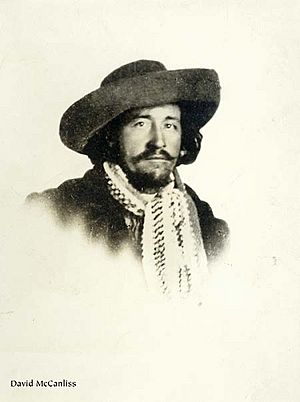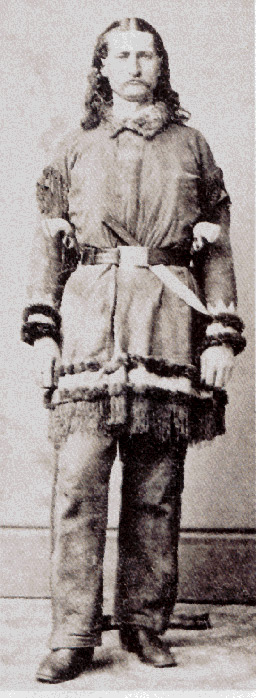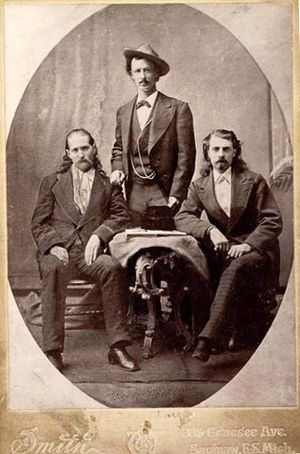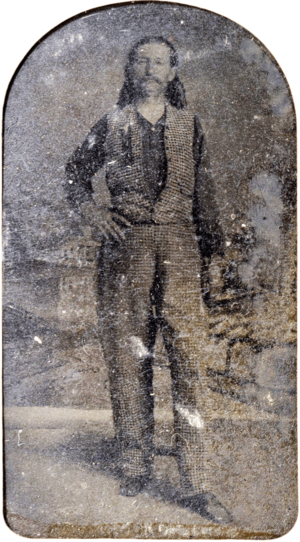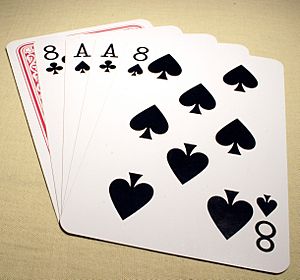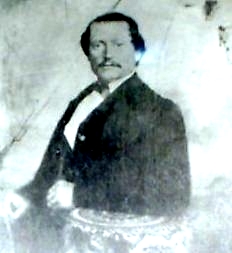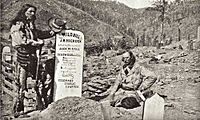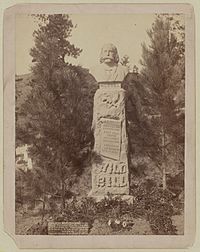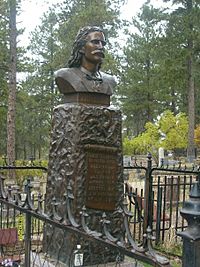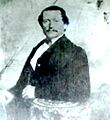Wild Bill Hickok facts for kids
Quick facts for kids
Wild Bill Hickok
|
|
|---|---|
 |
|
| Born |
James Butler Hickok
May 27, 1837 Homer, Illinois, U.S.
(now Troy Grove, Illinois, U.S.) |
| Died | August 2, 1876 (aged 39) Deadwood, Dakota Territory, U.S.
|
| Cause of death | Gunshot wound |
| Resting place | Mount Moriah Cemetery, Deadwood, Dakota Territory |
| Other names | James B. Hickok, J.B. Hickok, Shanghai Bill, William Hickok, William Haycock |
| Occupation |
|
| Spouse(s) |
Agnes Thatcher Lake
(m. 1876) |
| Parent(s) | William Alonzo Hickok and Polly Butler |
James Butler Hickok (May 27, 1837 – August 2, 1876), known as "Wild Bill" Hickok, was a famous person from the American Old West. He was known for his life on the frontier as a soldier, scout, lawman, and showman. He was also involved in several famous shootouts. Many stories about him were exaggerated, but they made him very famous.
Hickok grew up on a farm in Illinois. He moved west at age 18 and worked as a stagecoach driver. Later, he became a lawman in Kansas and Nebraska. He fought for the Union Army during the American Civil War. After the war, he became well-known as a scout, a great shot, and a professional card player.
In 1876, Hickok was shot and killed while playing poker in a saloon in Deadwood, Dakota Territory (present-day South Dakota). A man named Jack McCall killed him.
Hickok is still a popular figure in history. Many places and monuments remember his life. He has appeared in many books, movies, and TV shows. While some stories about him are not true, he is remembered as an important figure from the American frontier.
Wild Bill Hickok's Early Life
James Butler Hickok was born on May 27, 1837, in Homer, Illinois. This place is now called Troy Grove, Illinois. His father, William Alonzo Hickok, was a farmer and worked against slavery. His mother was Polly Butler. James was the fourth of six children. His family's house was said to be a stop on the Underground Railroad, helping enslaved people escape. His father died in 1852 when James was 15.
Hickok was a very good shot with a pistol from a young age. People in his town knew he was an excellent marksman. Even though photos show him with dark hair, everyone at the time said his hair was red.
In 1855, when he was 18, James Hickok left Illinois. He had a fight with Charles Hudson, and both fell into a canal. Each thought they had killed the other, but they were both mistaken. Hickok moved to Leavenworth in the Kansas Territory. There, he joined Jim Lane's Free State Army. This group worked against slavery during a time called Bleeding Kansas. While with this group, he met 12-year-old William Cody, who later became famous as "Buffalo Bill."
How Wild Bill Got His Nicknames
Hickok used his father's name, William Hickok, starting in 1858. During the American Civil War, he used the name William Haycock. Many newspapers called him William Haycock until 1869. After 1865, he went back to using James Hickok.
Before 1861, some people called him "Shanghai Bill" because he was tall and thin. After an event involving a man named David McCanles, he grew a mustache. In 1861, he started calling himself "Wild Bill."
Wild Bill's Early Career
In 1857, Hickok claimed a 160-acre piece of land in Johnson County, Kansas. In 1858, he was chosen as one of the first constables for Monticello Township. In 1859, he joined a freight company that was the parent company of the Pony Express.
In 1860, Hickok was badly hurt by a bear. He was driving a freight wagon when he saw a cinnamon bear and its two cubs blocking the road. He shot the bear in the head, but the bullet bounced off, making the bear angry. The bear attacked him, crushing his chest, shoulder, and arm. Hickok managed to shoot the bear again, wounding its paw, and then killed it.
Hickok was very injured and had to stay in bed for four months. After that, he was sent to Rock Creek Station in Nebraska to work as a stable hand while he recovered. This station was a stop along the Oregon Trail.
The McCanles Shooting Incident
On July 12, 1861, a man named David McCanles came to Rock Creek Station. He wanted an overdue payment for his land from Horace Wellman, the station manager. McCanles reportedly threatened Wellman. Either Wellman or Hickok, who was hiding, killed McCanles.
Hickok, Wellman, and another employee were put on trial for killing McCanles. But they were found to have acted in self-defense. This might have been the first person Hickok killed. Later, Hickok visited McCanles' widow. He apologized for the killing and offered her $35, which was all the money he had.
Serving in the Civil War
When the Civil War began in April 1861, Hickok became a teamster for the Union Army in Missouri. By the end of 1861, he was a wagon master. In September 1862, he left the army. He then joined General James Henry Lane's Kansas Brigade. While serving there, he saw his friend Buffalo Bill Cody, who was a scout.
In late 1863, Hickok worked as a detective for the military police in southwest Missouri. He helped find people who owed money to the Union Army. By early 1865, he was hired as a scout by General John B. Sanborn. In June, Hickok left the army and went to Springfield, where he played cards.
Lawman and Scout Roles
The Duel with Davis Tutt
While in Springfield, Hickok had arguments with a local card player named Davis Tutt. They disagreed about money Tutt owed Hickok from card games. They also liked the same women. Hickok lost a gold watch to Tutt in a poker game. This watch was very important to Hickok, so he asked Tutt not to wear it in public.
They first agreed not to fight. But when Hickok saw Tutt wearing the watch, he warned him to stay away. On July 21, 1865, the two men faced each other in Springfield's town square. They stood sideways, then quickly drew and fired their guns. Tutt's shot missed, but Hickok's shot hit Tutt, who died.
Two days later, Hickok was arrested for murder. The charge was later changed to manslaughter. He was released on bail and went to trial on August 3, 1865. The jury decided that Hickok had acted in self-defense and found him not guilty. This decision caused some public disagreement.
Weeks later, a journalist named Colonel George Ward Nichols interviewed Hickok. Nichols later became famous for creating the "Wild Bill" legend. An article was published in Harper's New Monthly Magazine. It called him "Wild Bill Hitchcock" and claimed he had killed "hundreds" of men. This article was controversial, and some newspapers said the stories were not true.
Deputy U.S. Marshal in Kansas
In September 1865, Hickok was recommended to be a deputy federal marshal at Fort Riley, Kansas. This was during the American Indian Wars, and Hickok sometimes worked as a scout for General George A. Custer's 7th Cavalry.
In 1865, Hickok organized an outdoor show called The Daring Buffalo Chasers of the Plains in Niagara Falls. He brought six Native Americans, three cowboys, six buffalo, a bear, and a monkey. The show was outdoors, so people didn't have to pay. It was a financial failure. One show ended badly when a buffalo wouldn't act. Hickok fired a shot into the sky, which angered the buffalo and scared the audience. The animals broke free and chased people, and some were trampled.
A reporter named Henry M. Stanley said Hickok "hated Indian People." This might have been to make Hickok seem like a better scout. But it's hard to know what's true because Hickok also hired Native Americans for his show. Witnesses said that while Hickok was a scout at Fort Harker, Kansas, in May 1867, he was attacked by a group of Native Americans. They ran away after he shot and killed two.
In December 1867, Hickok came to Hays City, Kansas. He became a deputy U.S. marshal. In March 1868, he arrested 11 Union Army soldiers who had left the army and stolen government property. Hickok was assigned to take them to Topeka for trial. He asked for military help and was joined by Buffalo Bill Cody and several soldiers. They arrived in Topeka on April 2.
Marshal of Hays, Kansas
In July 1869, Hickok returned to Hays and was elected city marshal of Hays and sheriff of Ellis County, Kansas. This was a special election held on August 23, 1869. Three sheriffs had quit in the past 18 months. Hickok might have been acting sheriff even before he was elected.
In September 1869, his first month as sheriff, Hickok killed two men. The first was Bill Mulvey, who was causing trouble in town. Mulvey said he came to town to kill Hickok. When he saw Hickok, he aimed his rifle. Hickok tricked him by yelling "Don't shoot him!" to some onlookers. Mulvey turned his horse, and Hickok shot him before he realized he'd been fooled.
The second man Hickok killed was Samuel Strawhun, a cowboy. Strawhun was causing a disturbance in a saloon at 1:00 am on September 27. Hickok and his deputy went to the scene. Strawhun "made remarks against Hickok," and Hickok killed him. Hickok said he was trying to bring order. A jury later found the shooting was justified.
On July 17, 1870, Hickok was attacked by two soldiers in a saloon. Hickok shot one, Jeremiah Lonergan, wounding him. He shot the other, John Kyle, killing him. Hickok lost his re-election bid to his deputy.
Marshal of Abilene, Kansas
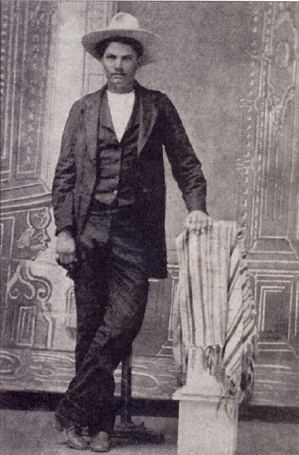
On April 15, 1871, Hickok became marshal of Abilene, Kansas. He took over from Tom "Bear River" Smith, who had been killed.
An outlaw named John Wesley Hardin arrived in Abilene in early 1871. Hardin was a well-known gunfighter. In his autobiography, Hardin claimed that Hickok, the new marshal, became his friend after Hardin disarmed him. However, Hardin was known to exaggerate his stories. Hardin seemed to respect Hickok's skills.
Hickok later said he didn't know that "Wesley Clemmons" was Hardin's fake name and that he was a wanted outlaw. Hickok told Clemmons (Hardin) to stay out of trouble and asked him to give up his guns, which Hardin did.
In August 1871, Hickok tried to arrest Hardin for killing a man in an Abilene hotel "for snoring too loud." Hardin left Kansas before Hickok could arrest him.
Shootout with Phil Coe
Hickok and Phil Coe, a saloon owner, had a disagreement that led to a shootout. Coe and his partner had painted a picture of a bull on their saloon. Town citizens complained to Hickok, who asked them to remove it. They refused, so Hickok changed it himself. Coe was angry.
On October 5, 1871, Hickok was trying to control a crowd during a street fight. Coe fired two shots. Hickok ordered him arrested for firing a pistol in the city. Coe said he was shooting at a stray dog, then suddenly turned his gun on Hickok. Hickok fired first and killed Coe.
After shooting Coe, Hickok saw someone running towards him. He quickly fired two more shots, accidentally hitting and killing Abilene Special Deputy Marshal Mike Williams, who was coming to help him. This was the last time Hickok was in a gunfight. The accidental death of Deputy Williams bothered Hickok for the rest of his life.
Hickok was removed from his marshal duties less than two months after this accidental shooting.
Wild Bill's Later Life
In 1873, Buffalo Bill Cody and Texas Jack Omohundro asked Hickok to join their acting group. Hickok did not enjoy acting. In one show, he shot the spotlight when it shined on him. He left the group after a few months.
Eye Problems
In 1876, a doctor said Hickok had glaucoma and ophthalmia, which are eye diseases. Even though he was only 39, his shooting skills and health were getting worse. He had been arrested several times for having no fixed home, even though he had earned good money from card games and shows just a few years earlier.
From 1871 until he died in 1876, Hickok had trouble with his vision. A former soldier who knew Hickok said that Hickok left Buffalo Bill's show "because the lights affected his eyes."
A medical expert from Harvard Medical School said that eye problems like "granular conjunctivitis" were common on the Western Frontier.
Marriage
On March 5, 1876, Hickok married Agnes Thatcher Lake, a 50-year-old circus owner, in Cheyenne, Wyoming Territory. Hickok left his new wife a few months later. He joined Charlie Utter's group to look for gold in South Dakota.
Shortly before he died, Hickok wrote a letter to his wife. Part of it said, "Agnes Darling, if we never meet again, while firing my last shot, I will gently breathe the name of my wife—Agnes—and with wishes even for my enemies I will make the plunge and try to swim to the other shore."
Calamity Jane claimed in her autobiography that she was married to Hickok. She said she divorced him so he could marry Agnes Lake. However, there are no records to support her story. They might have met for the first time when Jane joined the wagon train Hickok was traveling with. The wagon train arrived in Deadwood in July 1876.
Wild Bill's Death
On August 1, 1876, Hickok was playing poker at Nuttal & Mann's Saloon No. 10 in Deadwood, Dakota Territory. A man named Jack McCall sat down to play. McCall lost a lot of money. Hickok told McCall to stop playing until he could pay his debts and even offered him money for breakfast. McCall took the money, but he seemed insulted.
The next day, Hickok was playing poker again. He usually sat with his back to a wall so he could see the door. But the only seat open was facing away from the door. He asked another man to switch seats, but the man refused. McCall then walked into the saloon, came up behind Hickok, and killed him.
Jack McCall's Trials
People have wondered why McCall killed Hickok. Many think it was because McCall was angry that Hickok had given him money for breakfast after he lost so much.
McCall was first tried by an informal group of miners and businessmen. He claimed he was getting revenge because Hickok had killed his brother earlier. A man named Lew McCall had been killed by a lawman in Abilene, Kansas, but it's not known if they were related. McCall was found not guilty of the murder. This made people upset, and a newspaper wrote that if you wanted to get away with murder, you should have your trial in the mining camps.
After bragging about killing Hickok, McCall was arrested again. The second trial was held in Yankton, the capital of the Dakota Territory. Hickok's brother came from Illinois to attend. McCall was found guilty and sentenced to death.
A reporter interviewed McCall before his execution. Hickok's brother also spoke with McCall and said McCall showed no regret.
As I write the closing lines of this brief sketch, word reaches me that the slayer of Wild Bill has been rearrested by the United State [sic?] authorities, and after trial has been sentenced to death for willful murder. He is now at Yankton, D.T. awaiting execution. At the [second] trial it was suggested that [McCall] was hired to do his work by gamblers who feared the time when better citizens should appoint Bill the champion of law and order – a post which he formerly sustained in Kansas border life, with credit to his manhood and his courage.
Jack McCall was executed on March 1, 1877.
Wild Bill's Burial Site
Charlie Utter, Hickok's friend, took care of Hickok's body. He put a notice in the local newspaper that read:
Died in Deadwood, Black Hills, August 2, 1876, from the effects of a pistol shot, J. B. Hickock [sic] (Wild Bill) formerly of Cheyenne, Wyoming. Funeral services will be held at Charlie Utter's Camp, on Thursday afternoon, August 3, 1876, at 3 o'clock P. M. All are respectfully invited to attend.
Almost everyone in town went to the funeral. Utter had Hickok buried with a wooden grave marker that said:
Wild Bill, J. B. Hickock [sic] killed by the assassin Jack McCall in Deadwood, Black Hills, August 2, 1876. Pard, we will meet again in the happy hunting ground to part no more. Good bye, Colorado Charlie, C. H. Utter.
Hickok was buried in the Ingelside Cemetery, Deadwood's first graveyard. This cemetery quickly filled up. In 1879, three years after Hickok's first burial, Utter paid to move Hickok's remains to the new Mount Moriah Cemetery. Utter watched the move and noted that Hickok's body was well preserved. One worker wrote that Hickok's body felt like tapping a brick wall and weighed over 400 pounds (181 kg).
The original wooden grave marker was moved, but by 1891, souvenir hunters had destroyed it. It was replaced with a statue. This statue was also damaged by souvenir hunters and was replaced in 1902 with a life-sized stone sculpture. This, too, was badly damaged and put in a cage for protection. The cage was cut open in the 1950s, and the statue was removed.
Today, Hickok is buried in a 10-foot (3-meter) square plot at Mount Moriah Cemetery. It is surrounded by a metal fence.
Calamity Jane was reportedly buried next to Hickok, as she wished. However, some men who planned Calamity's funeral later said they did it as a joke because Hickok "had absolutely no use" for Jane when he was alive.
Pistols Carried by Wild Bill Hickok
Hickok's favorite guns were a pair of Colt 1851 Navy Model revolvers. They had ivory handles and were engraved with "J.B. Hickok–1869." He usually carried his revolvers with the handle facing forward, either in his belt or a sash. He rarely used holsters. He would draw the pistols using a "reverse" or "twist" draw, like a cavalry soldier.
When he died, Hickok was carrying a Smith & Wesson Model No. 2 Army revolver. This was a five-shot, .32-caliber gun. It was new for its time because it used metallic cartridges. Many Union officers liked it during the Civil War. This pistol was offered for sale in 2013, but it did not sell.
Images for kids
See also
 In Spanish: Wild Bill Hickok para niños
In Spanish: Wild Bill Hickok para niños



